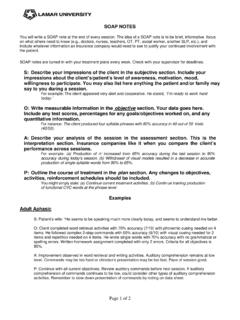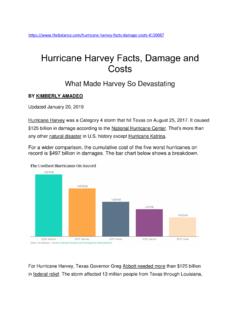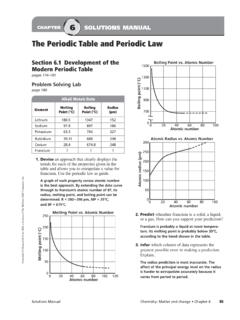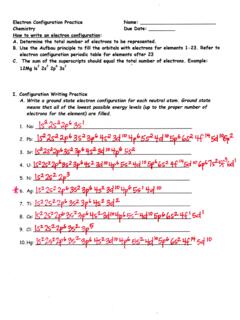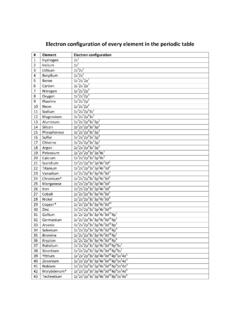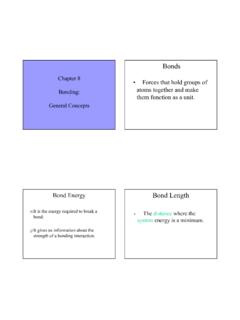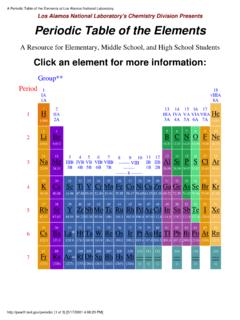Transcription of Chapter 7
1 Chapter 7. Effective Nuclear Charge Size of Atoms & Ions Ionization electron Affinity periodic TRENDS. Arises from the periodic patterns in electron CONFIGURATIONS. Elements in the same GROUP have the same number of VALENCE electrons VALENCE electrons = electrons in the outermost orbital EFFECTIVE NUCLEAR CHARGE. The NET positive charge experienced by an electron . Core electrons pulled in tightly Valence electrons held less tightly Shielding effect reduces the full nuclear charge of outer electrons Effective Nuclear Charge BASED On The periodic . RECURRENCE Of PROPERTIES. periodic Trends In Sizes of atoms and ions. Ionization energy. electron affinity. Sizes of atoms As we move down a group, the atoms become larger. Due to INCREASING value of n SIZES OF ATOMS. BUT !! As we move ACROSS a period, {left to right}.
2 Atoms become SMALLER. WHY ? As we move ACROSS the periodic table, the number of core electrons remains constant, but the nuclear charge increases Which of the following ATOMS is largest N , O , F ? S or O ? Na , Mg , Al ? Na or Cl ? Na or K ? CATIONS lose electrons and are SMALLER THAN THE PARENT ION. ION. ANIONS add electrons and are LARGER THAN THE PARENT ION. ION. Ions INCREASE. in size as you go down a column. Due to INCREASING. value of n. Sizes of Cations Sizes of Anions ISOelectronic series A group of ions all containing the same number of electrons How many electrons do O2- ; F- ; Na+ ; Mg2+ and Al3+ have ? 10. -- Increasing nuclear charge . O2- > F- > Na+ > Mg2+ > Al3+. --- Decreasing ionic radius . In an isoelectronic series Ionic size decreases with an increasing nuclear charge {See Text page 269}.
3 Which of the following is largest ? Na or K ? Na or Mg ? S2 or O2 ? S2 , S, or O2 ? K+, Cl , Ca2+, or S2 ? O 2- , F - , Na + , Mg 2+ , or Al 3+. Arrange the ions K+, Cl , Ca2+, and S2 in order of DECREASING size. These form an isoelectronic series of ions Size decreases as the nuclear charge of the ion increases. The atomic numbers of the ions are S (16), Cl (17), K (19), and Ca (20). Arrange O 2- , F - , Na + , Mg 2+ , Al 3+. according to size As nuclear charge increases in an isoelectronic series the ions become smaller IONIZATION ENERGY. Measure Of How Tightly An electron . Is HELD. By The NUCLEUS. IONIZATION ENERGY. How Much ENERGY is Required To REMOVE An electron From An ATOM In Its GROUND STATE. for example H H + + e- periodic Trends in Ionization Energies Ionization energy decreases going down a group Ionization energy generally increases across a period.
4 Ionization energy decreases down a group The outermost electron is more readily removed as we go down a group. Why ? The further the electron is from the nucleus the less tightly it is held Ionization energy generally increases across a period. As we move across a period, Zeff increases. Therefore, it becomes more difficult to remove an electron . electron Configuration of Ions Cations: electrons removed from orbital with highest principle quantum number, n, first: Li (1s2 2s1) Li+ (1s2). Fe ([Ar]3d6 4s2) Fe3+ ([Ar]3d5). Anions: electrons added to the orbital with highest n: F (1s2 2s2 2p5) F- (1s2 2s2 2p6). Ionization Energy & electron Affinity Ionization Energy change accompanying loss of electron Na Na+ + e . electron Affinity Energy change accompanying addition of electron Cl + e Cl . electron Affinities electron affinity is the opposite of ionization energy electron affinity is the energy change when an atom gains an electron Cl(g) + e- Cl-(g).
5 electron AFFINITY. THE ENERGY CHANGE. THAT OCCUR WHEN. AN electron IS ACCEPTED. BY AN ATOM. Cl + e- Cl - CLASSIFICATION. BASED ON SUBSHELL BEING FILLED. Representative Elements (s & p electrons). a) ALKALI Metals b) ALKALINE EARTH Metals Transition Elements (d electrons). Lanthanides & Actinides (f electrons). periodic TABLE. Divided Into PERIODS (ROWS) And GROUPS (COLUMNS). I. METALS. 1. REPRESENTATIVE. a) ALKALI GROUP IA. b) ALKALINE EARTH IIA. 2. TRANSITION (B GROUPS). II. METALLOIDS. III. NONMETALS. WHICH INCLUDE THE HALOGENS AND. THE NOBLE GASES. Selected Properties of Metals, Nonmetals and Metalloids The Alkali Metals Reactivity increases as we move down the group WHY? The Alkali Metals Alkali metals react with water to form the BASE MOH and hydrogen gas: 2M(s) + 2H2O(l) 2 MOH(aq) + H2(g). Alkali metal oxides 4Li(s) + O2(g) 2Li2O(s) (oxide).
6 2Na(s) + O2(g) Na2O2(s) (peroxide). K(s) + O2(g) KO2(s) (superoxide). Alkali metal oxides Metal oxide + water metal hydroxide Na2O(s) + H2O(l) 2 NaOH(aq). The Alkaline Earth Metals The chemistry is dominated by the loss of two s electrons: M M2+ + 2e-. Be does not react with water. Mg will only react with steam. Ca onwards: Ca(s) + 2H2O(l) Ca(OH)2(aq) + H2(g). Fig Oxygen Two allotropes: O2. O3, ozone Three anions: O2 , oxide O22 , peroxide O21 , superoxide The Oxygen Group As we move down the group the metallic character increases O2 a nonmetal, Te a metalloid, Po a metal halogens All halogens consists of diatomic molecules Fluorine is one of the most reactive substances known: 2F2(g) + 2H2O(l) 4HF(aq) + O2(g). H = kJ. The Noble Gases They are all nonmetals and monatomic. They are notoriously unreactive because they have completely filled s and p sub-shells.
7 In 1962 the first compound of the noble gases was prepared: XeF2, XeF4, and XeF6. To date the only other noble gas compounds known are KrF2 and HArF. Metals Metallic character increases down a group. Metallic character decreases across a period. Metals have low ionization energies All group 1A metals form M+ ions. All group 2A metals form M2+ ions. Most metal oxides are basic: Metal oxide + water metal hydroxide Na2O(s) + H2O(l) 2 NaOH(aq). Nonmetals Most nonmetal oxides are acidic: nonmetal oxide + water acid P4O10(s) + H2O(l) 4H3PO4(aq). CO2(g) + H2O(l) H2CO3(aq). Metalloids Metalloids have properties that are intermediate between metals and nonmetals. Metalloids have found fame in the semiconductor industry. End Chapter 7. Omit Sample & Practice Exercise and problems like it Start with : Sizes of atoms the following atoms in order of increasing effective nuclear charge experienced by the electrons in the n = 3.
8 electron shell K Mg P Rh Ti What information do I need to answer this question ? only the periodic table, arrange the following atoms in increasing radius (a) Cs K Rb ? < ? <? (b) In Te Sn ? < ? < ? (c) P Cl Sr ? < ? < ? Select the ions or atoms that are isoelectronic with each other (a) K+ Rb+ Ca+2 _____ & _____. (b) Cu+ Ca2+ Sc3+ _____ & _____. (c) S 2- Se 2- Ar _____ & _____. (d) Fe2+ Co3+ Mn2+ _____ & _____.



